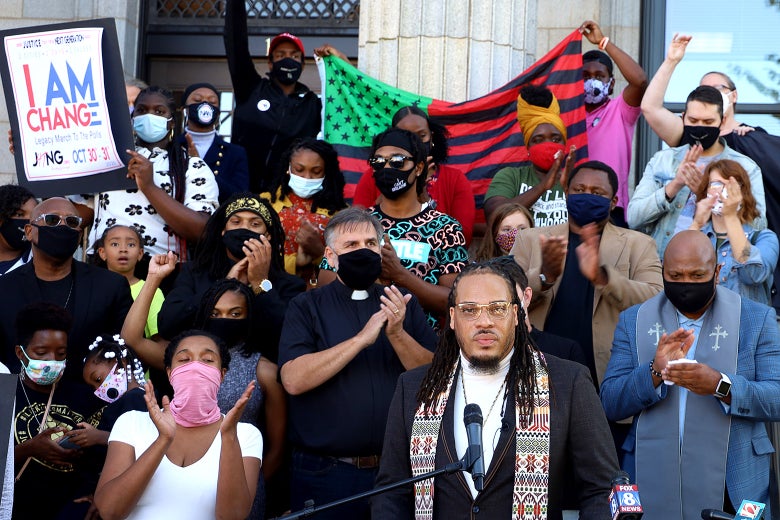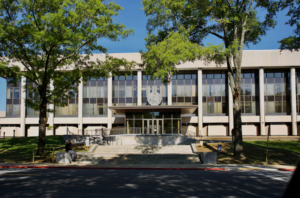A rural North Carolina county is working to turn anger over police brutality into lasting change.
On a sunny October afternoon, one day before the start of early voting, a small crowd of people gathered on the courthouse steps in the small city of Graham, North Carolina. Hoisting Black Lives Matter banners and green, red, and black flags, wearing face masks, they faced the 30-foot-tall Confederate statue they have repeatedly asked the county’s board of commissioners to remove.
Men in pickup trucks flying Thin Blue Line flags occasionally drove past, honking and shouting, but most in the crowd kept their eyes fixed on the Rev. Gregory Drumwright, the pastor of a large, youth-focused church and campus ministry in nearby Greensboro. He’d gathered people here to announce “I Am Change” marches in Greensboro and Graham on Oct. 30 and 31, the last two days of North Carolina’s early voting period.
“Our marching is about more than just a monument,” Drumwright told the crowd. “It’s about the systems of white supremacy, bigotry, and violence that shadow this monument.”
At a time when national media is laser-focused on the presidential race, and in a state that is a must-win for Donald Trump, no one at this gathering spoke Donald Trump’s or Joe Biden’s name. Instead, Drumwright repeated the names of victims of police and racial violence: Trayvon Martin, George Floyd, Breonna Taylor, Tamir Rice, Jonathan Price, Sandra Bland—and one long-ago victim, Wyatt Outlaw, the first African American appointed to the town council in Graham, lynched by white supremacists in 1870. Drumwright also called out the names of local elected officials—Sheriff Terry Johnson, whose department was sued by the U.S. Department of Justice under President Barack Obama for discriminatory policing against Latinos, and Bill Lashley Sr., an Alamance County commissioner who, in conversation with Johnson in May 2020, publicly praised police brutality in an open meeting.
“You can’t do now what we used to when I was on the force,” Lashley lamented at that meeting. “We used to beat the hell out of ’em!”
Lashley, whose term expires this year and whose son is now running as a Republican for an open commissioner seat, is also a vocal opponent of removing the Confederate monument. Drumwright doesn’t think that’s a coincidence. “This is the attitude of commissioners right here in Graham, North Carolina, that refuse to remove [or even] entertain conversations about removing this monument,” the reverend said.
Drumwright regularly passed the Graham courthouse’s Confederate monument while growing up in nearby Burlington; to him, it was just another statue. “It meant nothing to me,” he said, explaining that he had not been taught the statue’s history or significance as a symbol of white supremacy. He didn’t learn much about slavery, segregation, or the civil rights era until he left Alamance to study at North Carolina A&T, the largest historically Black university in the country.
Today the monument is at the center of a growing movement for political power in Alamance. In June, more than 50 community leaders—including mayors, school board members, clergy, and businesspeople—signed an open letter asking county commissioners “to relocate the monument in a respectful and appropriate manner.” When the commissioners refused, a coalition of local groups began weekly protests. On July 11, more than 700 protesters marched from Burlington to Graham, demanding its removal. Often met by neo-Confederate counterprotesters and police they say target them for harassment and arrest, they have demonstrated every weekend since.
Drumwright’s vision for the Halloween weekend marches is dramatic. He wants attendees of all ages and races to dress up, but not in the usual Marvel Comics or Disney princess costumes. “We’re gonna march down these streets with Skittles in our hands in honor of Trayvon Martin’s legacy,” Drumwright said near the end of his speech, his voice drowning out the sound of traffic. “We’re gonna march down these streets with hoodies on our heads, with George Floyd’s name on our backs.” To prepare for the march, organizers are relying on word of mouth, outreach to local churches and community centers, and social media posts. They hope that turnout will be enhanced by the promise of speeches from George Floyd’s niece, Brooke Williams, and civil rights attorney Benjamin Crump.
In both Graham and Greensboro, the marches will culminate at the polls. Black Lives Matter organizers locally and nationally have wrestled with the role of electoral politics in their broader call to end state-sanctioned violence against Black people. As a movement founded on grassroots principles, Black Lives Matter has no central leadership, and activists in the movement have declined to endorse political candidates. They have repeatedly made the point that the movement’s goals are larger than getting out the vote. But organizers in Alamance County hope that attention to local politics can motivate new and intermittent voters. They also see a chance to build political power that lasts beyond a single election.
Alamance County’s board of commissioners consists of five white Republicans who generally support the priorities of Sheriff Terry Johnson, who once instructed his deputies to “bring me some Mexicans.” In 2019, they voted to expand the county jail to detain asylum-seekers through a $2.3 million contract with Immigration and Customs Enforcement, provoking a wave of protests. Many local activists feel that Johnson, who has held office since 2002, stifles BLM and anti-ICE protest through intimidation and arrests.
“As soon as a demonstration starts, there’s so much police presence,” said Tanisha Richards, who works with Drumwright as a minister at the Citadel of Praise Church and lives in Alamance. “If you saw a bird’s-eye view of a protest, there’s a lot of herding that ends up happening. That’s what it feels like and looks like—you’re being herded.”
Drumwright was “called home,” as he says, by Quenclyn Ellison, president of the Alamance Alliance for Justice, in the spring. Ellison knew many people were afraid to speak out or demonstrate against pervasive racism that had only intensified since 2016. It was hard to speak out—Ellison often attends County Board of Commissioners meetings with fellow activists but, thanks to ever-changing rules, is rarely given a chance to speak. “We spend lots of time planning, but we don’t usually get heard,” she said. She’d followed Drumwright’s activism and hoped he could inspire a movement in place where, as the Guardian recently pointed out, some Black citizens are afraid to even put out yard signs for progressive candidates or voice support for BLM.
Drumwright was surprised and disheartened by the fear he heard at their first organizing meeting, attended by about 20 Black and Latinx religious and community leaders at Morgantown Baptist Church. Though he knew that Alamance had a history of white supremacy and neo-Confederate groups, he had not expected people to be afraid to march. “I was taken aback at how deeply the system of racial oppression had manifested itself there in Alamance County. Those same people who are [now] challenging that system sat in a room with me and said, ‘Do you think it’s OK that we tell people that we’re talking and meeting about this?’ Those same people were hesitant to even announce the march.”
Clearly, there was work to do—not just organizing and building awareness, but also educating people about the rights of citizens and the role of public officials.
“Most people can’t tell you what a county commissioner does,” said Rion Thompson, a local activist and campaign manager for Alamance County commissioner candidate Dreama Caldwell, who if elected will become the first Black woman commissioner in the county’s history. “That is intentional.”
Local elections will affect the funding of public schools, determine the sheriff’s budget and ability to negotiate contracts with ICE, and direct the county’s response to citizens’ concerns and complaints, like the repeated requests to relocate the Confederate monument. These decisions have a broader economic impact, said Bob Byrd, who served for four years as the only Democrat on the Alamance Board of Commissioners before being voted out in 2014. Byrd is running for reappointment to the board this year, along with two other Democrats. “If you believe in a strong system of public education, it matters,” he said. “If we want to have a community that’s welcoming to everyone, it makes a difference.”
Ellison, Drumwright, Thompson, and other leaders in the movement—almost all of them under 40 years old—are working to educate an electorate that has been largely ignored by both parties. They’re betting that a focus on local issues, like policing, and down-ballot candidates with deep investment in the community, like Caldwell, will inspire young people to vote—and to demand accountability from elected officials accustomed to ignoring them.
Spencer Blackwell, a 24-year-old organizer who helped plan the march in July, smiled when asked what he knew about the county commissioners race. “Ms. Dreama?” he asked. “She was my Head Start teacher.”
Alamance, a mostly rural county west of Chapel Hill, was once known for textile mills and hosiery manufacturing. The county’s mills and factories were almost all closed in the 1990s as the textile industry moved overseas or to Mexico, and many of the old brick mill buildings along the Haw River have been converted into lofts, charter schools, and businesses serving the new residents who work in Chapel Hill, Durham, and Greensboro.
Though the higher incomes of these commuters keep Alamance’s poverty rate about average for the state—13 percent—Alamance’s child poverty rate, 27 percent, is significantly higher than the state or national average. A quarter of all Alamance households lack broadband internet access.
Occasionally Alamance makes national news—usually for something unfortunate. This year, you might have heard about Alamance’s Ace Speedway, a stock car racetrack which operated before packed stands in defiance of the governor’s orders, or about the city of Graham’s controversial ban on public protests, which had to be enjoined by a federal judge after a lawsuit filed by the Alamance NAACP branch and eight individuals, including Drumwright.
This year’s protests started after the state’s March 3 presidential primary, so the upcoming election will be the first test of the movement’s electoral power.
“I always struggle with trusting a process that was made to exclude people who look like me,” said Thompson, describing the near-constant redistricting and racial gerrymandering that dilute Black voters’ power, including prison-based gerrymandering, which inflates the census counts in many rural communities. North Carolina is one of only eight states requiring a witness signature for mail-in ballots, an obvious problem for older voters and other people at higher risk for COVID-19 complications or death. “We do not center the voting process on the most marginalized folks,” said Thompson.
Additionally, Black voters in North Carolina are over three times more likely than white voters to have their mail-in ballots rejected, and thanks to a ruling from a federal judge, voters are no longer able to correct ballots missing a witness signature, or even with minor deficiencies, with an affidavit. They have to recast their ballots by mail or in person. Although the North Carolina State Board of Elections extended the deadline for receipt of mail-in ballots to Nov. 12 as long as they are postmarked on Election Day, Republican state legislators challenged the decision in court. The 4th Circuit ruled in favor of the extended deadline, but the Supreme Court, following Monday’s 5–3 decision blocking an extended ballot deadline in Wisconsin, seems likely to reverse that decision.
Ernest Lewis, third vice chair of the Alamance Democratic Party, said that, while he knows the board is trying its best to reach voters with rejected ballots, time is short. “I’m concerned about it,” he said. “Are we going to reach those people fast enough?”
By Friday, Oct. 23, about 33 percent of Alamance County’s voters had cast their ballots by mail or early voting, and organizers predict that by the time polls close on Nov. 3, between 72 and 75 percent of registered voters will have voted, a significant increase over the 70 percent turnout recorded by the county in 2016. How many of these voters are the more left-leaning millennials or Gen Z may decide the outcome for local races and even the presidency.
Though the organizers in Alamance look forward to marching new voters to the polls, they hope that participants come away from the experience with more than a single-use “I Voted” pen.
“One of the narratives that’s always pushed to us is that we need to vote, and that’s not wrong. But George Floyd and Breonna Taylor were not killed due to not voting or not being registered to vote,” Thompson said. “I will be remiss if I do not make the point that [voting] is not enough and it has never been enough.”
The goal of the Halloween weekend marches varies, depending on whom you ask.
For educator and activist Kani Adon Bynum, it’s about building relationships. “My goal is to meet and network with like-minded people,” he said. “These people are my family.”
For Ellison, whose niece and daughter watched her speak at the event, it’s about making her hometown a safer, more welcoming, equitable place for families like hers. Ellison plans to attend the march with her daughter Malyiah, a 10th grader who wonders why, at her school, they “never talk about the real stuff,” or learn about the history right under their feet.
And for Drumwright, it’s about making sure that the county where he grew up, and where many in his family still live, is not left behind.
“Change is already happening all over America,” he said, referring to the long early voting lines at early voting polling places around the country. “Alamance County will not be an exception.”




